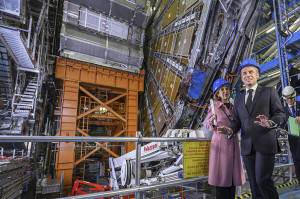Mysteries of universe revealed? Hardly. But CERN still fascinates,
discovers on its 70th anniversary
 Send a link to a friend
Send a link to a friend
 [October 01, 2024]
By JAMEY KEATEN [October 01, 2024]
By JAMEY KEATEN
GENEVA (AP) — The research center that is home to the world’s largest
particle accelerator is celebrating its 70th anniversary on Tuesday,
with the physicists who run it aiming to unlock secrets about dark
matter and other mysteries to promote science for peace in today's
conflict-darkened world.
Over the last seven decades, CERN, the sprawling research center on the
Swiss-French border at Geneva, has become a household name in Europe,
the West and beyond, but its complex inner workings remain a puzzle to
many people.
Here's a look at CERN and how its discoveries have changed the world and
our view of the universe — and could change them more in coming years.
What is CERN?
The European Organization for Nuclear Research, which has retained the
French-language acronym CERN for its predecessor outfit, had its origins
in a 1951 meeting of the U.N.’s scientific organization that sought to
build a state-of-the-art physics research facility in Europe and ease a
brain drain toward America after World War II. Groundbreaking was on May
17, 1954.
Today, for cognoscenti, CERN is probably best known as home to the Large
Hadron Collider, trumpeted as the world’s biggest machine, which powers
a network of magnets to accelerate particles through a 27-kilometer
(17-mile) underground loop in and around Geneva and slam them together
at velocities approaching the speed of light.
By capturing and interpreting the results of the collisions — as many as
a billion per second — of such beams of particles, thousands of
scientists both on hand at the center and remotely around the world pore
over the reams of resulting data and strive to explain how fundamental
physics works.

CERN says collisions inside the LHC generate temperatures more than
100,000 times hotter than the core of the sun, on a small scale and in
its controlled environment.
At the LHC, “we are able to reproduce every day the conditions of the
primordial Universe as they were a millionth of a millionth of a second
after the Big Bang. Yet, many crucial open questions remain,” CERN
Director-General Fabiola Gianotti said in a prepared speech she was to
make before many leaders of its 24 member countries.
Over the years, CERN and its experimental facilities have grown into a
vast research hub with applications in many scientific fields and
industries.
“In a world where conflicts between countries, cultures and religions
sadly persist, this is a truly precious gift that cannot be taken for
granted,” Gianotti added in an advance copy of the speech provided to
the AP.
How has CERN changed our world and our understanding of the universe?
Experiments in the collider helped confirm in 2012 the subatomic Higgs
boson, an infinitesimal particle whose existence had been theorized
decades earlier and whose confirmation completed the Standard Model of
particle physics.
CERN is also where the World Wide Web was born, in the mind of British
scientist Tim Berners-Lee 35 years ago, as a way to help universities
and institutes share information. In 1993, the software behind the web
was put into the public domain — and the rest is history, in smartphones
and on computers worldwide.
[to top of second column]
|

Fabiola Gianotti, left, Director General of the European
Organization for Nuclear Research (CERN), and French President
Emmanuel Macron, front, visit the ATLAS experiment, at the CERN (the
European particle physics laboratory), in Meyrin near Geneva,
Switzerland, Thursday, Nov. 16, 2023. (Martial Trezzini/Keystone via
AP, Pool, File)

The spillover science and tools generated at CERN have rippled
through the world economy. Thousands of smaller particle
accelerators operate around the world today, plumbing applications
in fields as diverse as medicine and computer chip manufacturing.
Crystals developed for CERN experiments roughly four decades ago are
now widely used in PET scanners that can detect early signs of
health troubles like cancer and heart disease.
Some skeptics have over the years stirred fears about CERN. Insiders
variously argue and explain that such fears are overblown or
inaccurate, and CERN has issued its own retort to some of the
theories out there.
What the future holds
For the most part, CERN technicians, researchers and theoreticians
of more than 110 nationalities today carry out new experiments that
aim to punch holes in the Standard Model — smashing up conventional
understandings to move science forward — and explain a long list of
lingering scientific unknowns.
Its scientific whizzes hope to solve riddles about dark energy —
which makes up about 68% of the universe and has a role in speeding
up its expansion — and test hypotheses about dark matter, whose
existence is only inferred and which appears to outweigh visible
matter nearly six-to-one, making up slightly more than a quarter of
the universe.
CERN has two big projects on its horizon. The first is the
High-Luminosity LHC project that aims to ramp up the number of
collisions — and thus the potential for new discoveries — starting
in 2029.
The second, over the much longer term, is the Future Circular
Collider, which is estimated to cost 15 billion Swiss francs (about
16 billion euros or $17.2 billion) and is hoped to start operating
in an initial phase by 2040.
Despite its aim to foster scientific progress in the cause of peace
and humanity, CERN has found itself ensnared in politics.
Its constitution says the organization “shall have no concern with
work for military requirements.” In 2022, CERN's governing council
voted to pause ties with institutes in Russia because of President
Vladimir Putin’s order for Russian troops to invade Ukraine earlier
that year. Some fear that applications from CERN's research could
make their way into Moscow's war machine.
On Nov. 30, CERN will formally exclude Russia — affecting some 500
scientists, about 100 of whom have joined non-Russian institutes in
order to maintain their research with the center.
The suspension will come at a cost, depriving CERN of some 40
million Swiss francs in Russian financing for the High-Luminosity
LHC. It amounts to about 4.5% of the budget for its experiment,
which will now have to be shouldered by other CERN participants.
All contents © copyright 2024 Associated Press. All rights reserved
 |